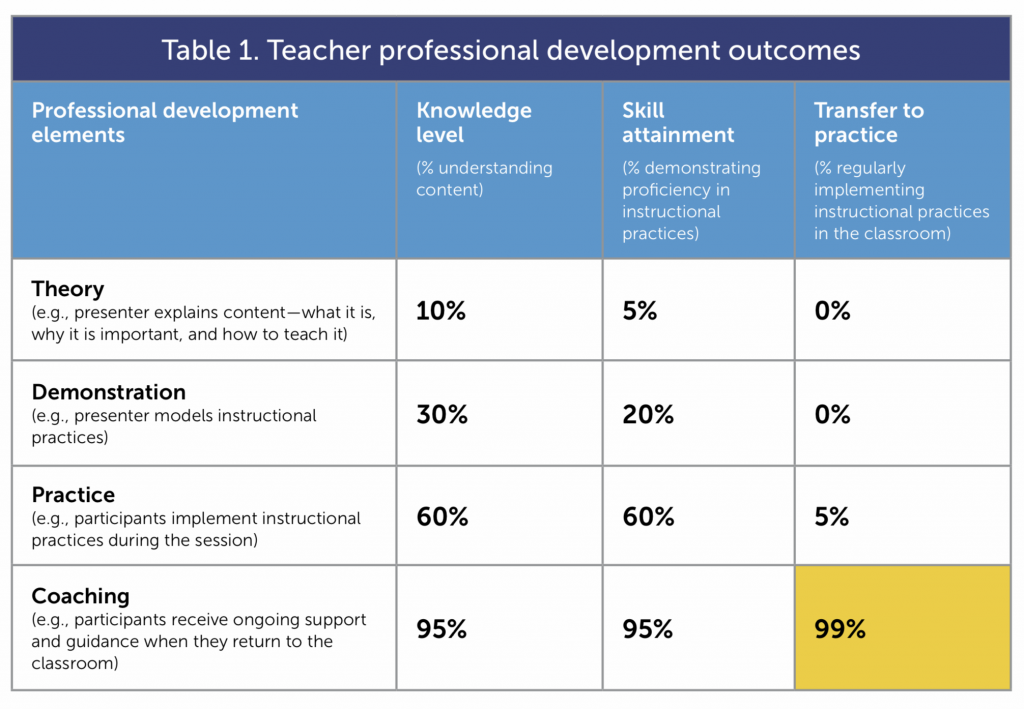
The ISTE Standards for Coaches 1a, “Create a shared vision and culture for using technology to learn and accelerate transformation through the coaching process,” demonstrated to me the importance of looking for and creating a common culture around which technology usage can be centered during the transformational process of coaching. The following blog excerpts highlight aspects of this learning touched on in each of the corresponding blogs.

Source: Digital Learning Mission Statement
Evidence: “My mission as a STEM educator is to seek ways to advance the work of closing opportunity gaps and achievement gaps for all students with an emphasis on equitable STEM education.”
Explanation: My mission statement demonstrates the fundamental philosophical place from whey I approach creating a shared vision.

Source: Is Coaching Remotely Necessary in the Era of Remote Learning?
Evidence: “Moving from “why” to “what” with regard to peer coaching means moving from supporting research and anecdotal stories to what instructional coaching actually looks like. Dr. Les Foltos outlines the core skills required in chapter 3 of his book: “Think of a successful coach sitting on the stool in Figure 3.1. The coach’s success rests on her ability to utilize skills in all three areas: coaching skills (communication and collaboration), ICT (information and communication technology) integration, and lesson design. Remove any leg and coaching could fail.” So first and foremost, communication and collaboration are the foundation of coaching skills. While Dr. Foltos lists information and communication technology integration second, he actually describes the technology component as being secondary to both coaching skills and lesson design. Communication skills are a recurring theme while learning is clearly emphasized as top priority with technology serving in secondary be essential supporting role, “It is not (never was) about technology. To make a difference, it has always been about good teaching, reflecting and focusing on (relevant?) student learning. (Sylvia Tolisano, 2009)”.”
Explanation: Creating a shared vision requires a common foundation. Dr. Foltos’s core skills of peer coaching provide one such possible starting point for utilizing technology and accelerating transformation of an instructional culture, e.g., building, district, organization, etc.

Evidence: “Teaching is a hard job in the best of times. Add in a pandemic that requires the ability to teach in-person, remotely, or some combination there-of, and more questions than answers will surely arise. Teachers need help and support and hopefully this is where peer coaches can come into play, but where do coaches even begin to establish the complex level of support needed by teachers? In Dr. Les Foltos’s book, Peer Coaching: Unlocking the Power of Collaboration, he outlines key skills needed by coaches: “The coach’s success rests on her ability to utilize skills in all three areas: coaching skills (communication and collaboration), ICT (information and communication technology) integration, and lesson design.” All three areas are important, but the coaching skills of communication and collaboration are essential. Both ICT integration and lesson design are dependent upon effective communication and collaboration, “A coach’s successes in incorporating lesson-design skills and insights into the effective use of technology “hinge on their success with communication and collaboration skills” (J. Linklater, personal communication, June 14, 2012).” A closer look at coaching skills also requires relevant context since the peer coach takes on a variety of roles: “Facilitator, Collaborator, Expert, and Catalyst.” Successful coaching requires that effective application of skills coincides with, complements, and even enhances the critical context of coaching roles.”
Explanation: Empathy plays a critical role in being able to meet peers where they are at and to help create a shared vision together. In addition to key coaching skills, Dr. Foltos describes the variety of roles that successful coaches take on as they accelerate transformation through a shared vision.

Source: Teaching by Design, Part Deux
Evidence: “The first post in this two-part series highlighted some key aspects from Dr. Les Foltos’s book, “Peer Coaching: Unlocking the Power of Collaboration,” starting with his foundational outline of three general areas of skills that instructional coaches should possess: “The coach’s success rests on her ability to utilize skills in all three areas: coaching skills (communication and collaboration), ICT (information and communication technology) integration, and lesson design.” When focusing on the lesson design leg of the stool, Dr. Foltos provides a “Learning Activity Checklist” tool for reviewing and improving lesson plans. So far in this series, we’ve explored the “Standards Based” category and the “Engaging” category. Both are critical quadrants of the four-part resource. The two remaining categories to address are “Problem Based Task” and “Technology Enhances Academic Achievement”. With the same ISTE standards and essential question in mind as the initial post, we’ll explore each category to round out a full review of the four categories from Dr. Foltos’s “Learning Activity Checklist” tool.”
Explanation: A common outline of instructional approaches, or “Learning Activity Checklist as Dr. Foltos calls it, establishes a common language for approaching, discussing, and evaluating learning and instructional technology. Speaking the same language when it comes to instruction helps educators to more easily move forward together as they accelerate transformation through the coaching process.

Source: Professional Learning Can Be ‘Squirrelly’ Business
Evidence: “The vast majority of what makes professional learning high quality applies to trainings whether they are focused on educational technology or not. In fact, focusing in on cutting edge, advanced, or complicated technology as part of a professional learning example often distracts from the more general topic of good professional learning. Since good professional learning is good professional learning whether technology focused or not, the guiding questions really kept bringing me back to particular low-tech professional learning experience that I had. It was one of the best that I led as an instructional coach because of some very unique circumstances, and I think the lessons that I learned apply to all professional learning whether low tech, high tech, or even no tech.”
Explanation: Before utilizing educational technology as a means to accelerating instruction, a common fundamentally sound approach to instruction independent of technology needs to be established. Then instructional technology can truly be utilized to accelerate transformation with the support of coaching.

1b Equitable use of digital learning tools
